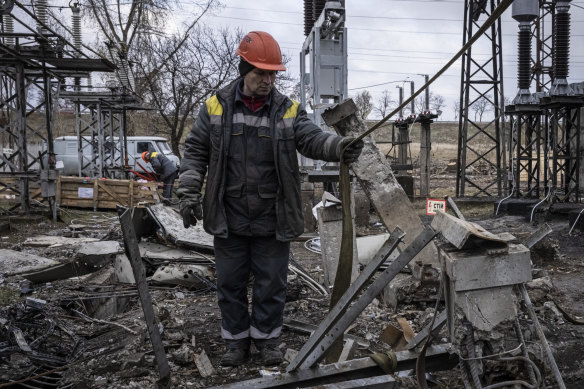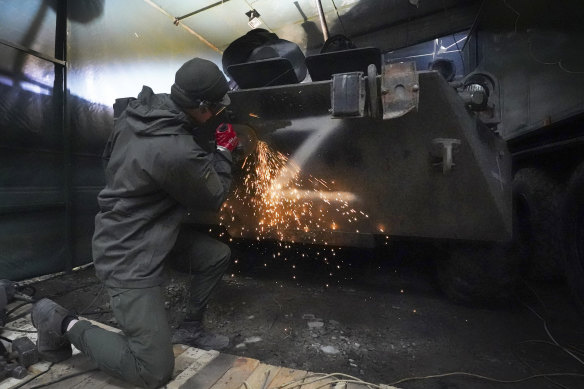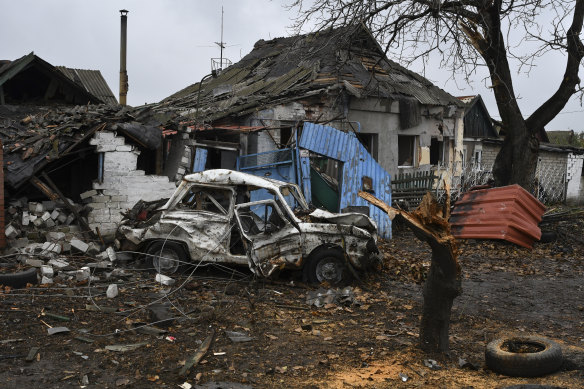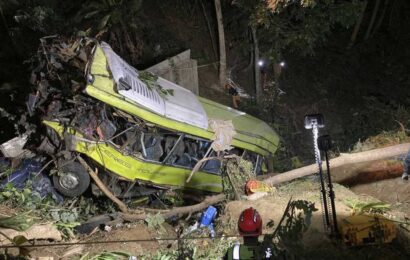Washington: The US Defence Department is setting up a new command to oversee how the United States and its allies train and equip the Ukrainian military, it has announced along with a new package of $US400 million in security assistance.
The Pentagon’s commitment to supplying Ukraine with weaponry and the new command are clear signals the US expects the threat from Russia to Ukraine and its neighbours to persist for many years, current and former senior American officials said.
Workers repair infrastructure in a power plant that was damaged by a Russian air attack in Kyiv Oblast, Ukraine. Drone strikes are causing electricity and heating outages across Ukraine.Credit:Getty Images
The command will “ensure we are postured to continue supporting Ukraine over the long term,” Sabrina Singh, deputy Pentagon press secretary, told reporters at a news briefing on Saturday (AEDT). “We remain committed to Ukraine for as long as it takes.”
In the military, a command is a focused organisation dedicated to a particular geographical or strategic area. The new command, called the Security Assistance Group-Ukraine, or SAG-U, will be based in Germany and within the structure of the Pentagon’s European Command. With a staff of about 300 people, it will be focused on one mission: to help train and equip Ukraine’s military.
The new command will streamline a training and assistance system that was created on the fly after the Russian invasion in February. The New York Times reported in September that the new structure was in the works.
A Ukrainian National Guard soldier cleans away a Z letter, a sign of the Russian army, from a captured Russian tank in the outskirts of Kharkiv.Credit:AP
The revamped assistance program will be led by a high-ranking general who will replace Lieutenant General Christopher Donahue, the head of the Army’s 18th Airborne Corps, who has coordinated much of the US military assistance to Ukraine from behind the scenes over the past several months.
A leading candidate to take over the new position is Lieutenant General Antonio Aguto jnr, the head of the 1st US Army headquarters, located at Rock Island Arsenal in Illinois, military officials said.
The additional $US400 million in security assistance includes, for the first time, funding to refurbish 45 tanks from the Czech Republic, which will start arriving in Ukraine by the end of December, Singh said. The funding also will go to contracts for 1100 Phoenix Ghost drones and an additional 40 riverine boats.
The latest announcement brings to $US18.9 billion the amount in military assistance that the United States has committed to Ukraine since Russia invaded its neighbour on February 24. The funds comprise a combination of immediate shipments from stockpiles as well as contracts for weapons to be delivered over the next three years.
A damaged Soviet-era Ukrainian car “Zaporozhets” next to a destroyed apartment building after Russian shelling in Pokrovsk, Donetsk, Ukraine, on Friday.Credit:AP
Over the past several months, Donahue, who commanded the US evacuation from Afghanistan in August 2021, has helped oversee training in Ukraine, talking to Ukrainian generals about their battlefield needs and drawing on his Special Operations background to advise his Ukrainian counterparts.
Donahue and his staff have been deployed to Poland and Germany since the early days of the war. His staff recently returned to its main headquarters at Fort Bragg, North Carolina, where they were greeted this week by Defence Secretary Lloyd Austin. Donahue will remain in Germany until his successor arrives, Pentagon officials said.
The new command, which will report to General Christopher Cavoli, the top US officer in Europe, will carry out the decisions made by the Ukraine Defence Contact Group, a coalition of 40 countries that the Defence Department created after the Russian invasion to address Ukraine’s needs and requests. Senior military officials from the member nations met in Brussels this week.
The changes, which aim to give a formal structure to what has been improvised since the war’s onset, are roughly modelled on US train-and-assist efforts in Iraq and Afghanistan over the past two decades.
This article originally appeared in The New York Times.
Most Viewed in World
From our partners
Source: Read Full Article










